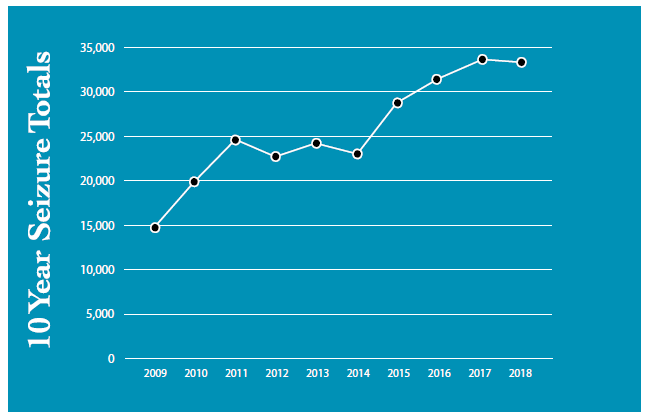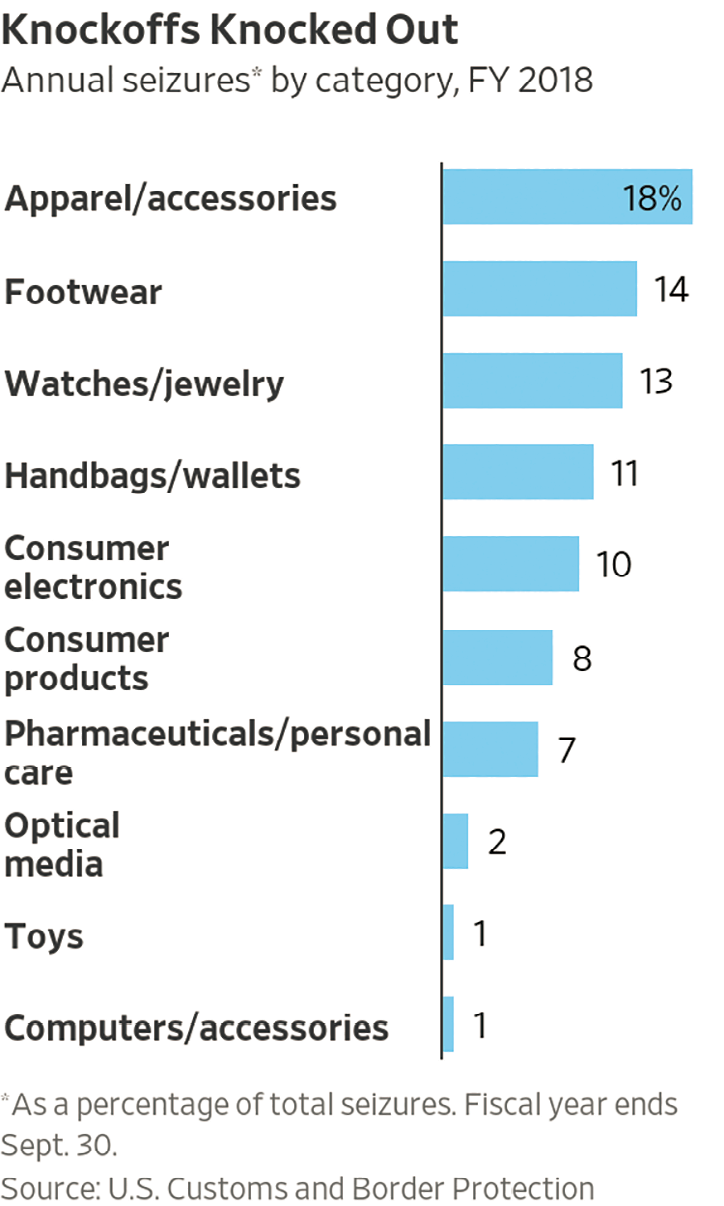Intellectual Property Rights and International Trade: an Overview of U.s. Customs and Border Protection's Enforcement of Intellectual Property Rights
| Publication year | 2020 |
| Author | Bruce A. McDonald |
Bruce A. McDonald*
Cameron W. Roberts**
On January 24, 2020, The Wall Street Journal reported:1
The Trump administration is moving to curb the sale of imported counterfeit goods over the internet, warning electronic commerce platforms and warehouse operators of greater scrutiny and penalties if they don't help ferret out fakes.
The Department of Homeland Security is set to release a report Friday outlining its immediate actions and longer-term goals for enlisting e-commerce players to combat counterfeit products that officials say undermine U.S. technology and manufacturing, harm bricks-and-mortar retailers and endanger consumers.
The new initiative, led by U.S. Customs and Border Protection and the White House,2 comes the same month as an initial trade agreement with China that requires Beijing to take steps against counterfeiters or risk enforcement actions that could trigger new tariffs.

Image description added by Fastcase.
Source: U.S. Customs and Border Protection, "Intellectual Property Rights: Fiscal Year 2018 Seizure Statistics" (August 2019) https://www.cbp.gov/sites/default/files/assets/documents/2019-Aug/IPR_Annual-Report-FY-2018.pdf
Intellectual property theft is a widespread commercial concern3 affecting international trade,4 national security,5 and public safety.6 United States (US) Customs and Border Protection (CBP) seizures of imported merchandise7 that violate intellectual property rights (IPR) are on the rise.8 The incidence of infringing merchandise at US borders has increased from 3,244 seizures in 2000 to 33,810 in 2018, according to the US Department of Homeland Security data.9
This article provides an overview of US and international IPR law from the standpoint of IPR owners10 and importers, describes the measures necessary for registration and enforcement of IP rights at the US border, and outlines common issues that arise in enforcement proceedings involving counterfeit and infringing merchandise. This article also summarizes the issues facing intellectual property owners and importers when allegedly counterfeit and pirated merchandise is seized by the government, either in an administrative proceeding brought by CBP or in a criminal proceeding by the US Justice Department. In short, this article facilitates a general understanding of IPR, how to protect IPR, and how to report and prevent infringement.11
[Page 9]
Intellectual property comes in many forms, but those of greatest interest to importers and IP owners seeking to exclude counterfeit and infringing merchandise at the US border are trademarks and trade names, copyrights, and patents. This section covers the enforcement against infringement of such items.
A. Trademarks and Trade NamesCBP recognizes three levels of infringement in its enforcement of trademarks: counterfeit marks, confusingly similar marks, and restricted gray market merchandise, i.e., parallel imports.12
1. Counterfeit MarksUnder section 45 of the Federal Trademark Act of 1946, as amended (the Lanham Act), 15 U.S.C. § 1127, a counterfeit mark is a spurious mark that is identical to, or substantially indistinguishable from, a federally registered trademark. Merchandise imported with counterfeit marks that are registered trademarks and recorded with CBP is subject to seizure followed by the institution of forfeiture proceedings.13 The statutory language is mandatory: such merchandise "shall" be seized and, absent the trademark owner's written consent to import the merchandise, forfeited, for violation of customs laws.14
After forfeiture, CBP customarily destroys counterfeit merchandise. But if the merchandise is safe, poses no health hazard, and the trademark owner consents, then CBP may "obliterate" the counterfeit mark where feasible and dispose of the seized merchandise by turning over the merchandise to any federal, state, or local government agency, donating the merchandise to a charitable institution, or selling the merchandise at public auction, provided that more than ninety days have passed since the date of forfeiture and no agency or charitable institution needs such merchandise. CBP may impose a civil fine against any person who directs, assists financially or otherwise, or aids and abets the importation of merchandise bearing a counterfeit mark.15
Merchandise bearing a registered trademark that is not recorded with CBP, by contrast, is subject to seizure "where administratively feasible and appropriate." That is, CBP is authorized, but not statutorily required, to seize merchandise bearing a mark that is a counterfeit of a federally registered trademark that is not recorded with CBP.16

Image description added by Fastcase.
A mark or trade name is one that so resembles a recorded mark or name as to be likely to cause the public to associate the copying or simulating mark or name with the recorded mark or name.17 Merchandise bearing a copying or simulating mark is subject to detention and seizure.18 Such merchandise is also denied entry and detained for thirty days from the date when it is presented for examination by CBP, during which time the importer has an opportunity to establish that any of the circumstances described in 19 C.F.R. § 133.22(c) are applicable, e.g., the accused mark is removed or obliterated as a condition to entry, or the recordant gives written consent to the importation.19 If the importer has not obtained release of the merchandise within the thirty-day detention period, then the merchandise is seized and forfeiture proceedings instituted. Imported merchandise or packaging in which trademark or trade name violations are involved may be seized and forfeited under 19 U.S.C. § 1595a(c)(2)(C) and 19 C.F.R. § 133.22(f). But merchandise bearing a mark that is confusingly similar to a trademark registered with the US Patent and Trademark Office (USPTO), but which is not recorded with CBP, is not subject to detention or seizure.
[Page 10]
3. Restricted Gray Market Articles ("Parallel Imports")Gray market merchandise is merchandise manufactured abroad bearing a genuine trademark or trade name that is identical to, or substantially indistinguishable from, one owned and recorded by an American citizen or US business that is imported into the US without the authorization of the US trademark owner. Gray market merchandise is a genuine product bearing a trademark or trade name that has been applied with the approval of the owner for use in a foreign country. Only trademarks and trade names that are recorded with CBP are entitled to gray market protection.20 Gray market protection takes effect on the date of recordation with CBP, and is limited to instances where the US and foreign trademarks are not owned by the same person, and the US and foreign trademark owners are not a parent or subsidiary, or otherwise subject to common ownership or control. "Common ownership" means individual or aggregate ownership of more than fifty percent of the business entity. "Common control" means effective control in policy and operations.21
If a trademark or trade name meets the criteria for gray market protection, then foreign-made products bearing the protected mark or name that are imported into the US will be detained under 19 C.F.R. §§ 133.23 and 133.25, except as provided in 19 C.F.R. § 133.23(b), and are subject to potential seizure and forfeiture under 19 U.S.C. § 1526(b).22
B. CopyrightsCBP can detain or seize piratical copies of protected copyrighted works. "Piratical copies" are identical or substantially similar copies of a registered copyrighted work that are produced and imported without authorization from the copyright owner.23 While copyright protection exists the moment a work is fixed in any tangible medium of expression, CBP focuses its enforcement of copyrighted works that have been recorded with the agency. CBP only records claims to copyrights that are registered with the US Copyright Office.24
Copyright law prevents the copying of a copyrighted work in any medium. The determination of copyright piracy is based on whether an average observer would recognize the alleged infringement as a copy of the copyrighted work.25 That requires a plaintiff to prove access to the copyrighted work and a substantial similarity between the works,26 not only as between general ideas, but also as between the expressions of those ideas.27 Access to the copyrighted work may be presumed without direct evidence that the importer had an opportunity to view the copyrighted work. The substantial similarities between the works may be so striking as to preclude the possibility that they were created independently.28 CBP regulations provide for the possibility of border enforcement action to enforce the Copyright Act of 1976 where the suspect work is clearly or possibly piratical.29
1. Clearly Piratical"Clearly piratical" is defined by CBP as overwhelming and substantial similarity between the copyrighted elements of the protected work and the suspect item so as to clearly indicate that latter is based on the former.30 Imported merchandise constituting "clearly piratical" copies of a federally registered copyright recorded with CBP is subject to seizure and forfeiture under 19 U.S.C...
To continue reading
Request your trial
